Motorless in the Motor City: The Inner Circle Greenway Route
Take a bicycle tour with WDET and learn about the city’s next potential greenway route.
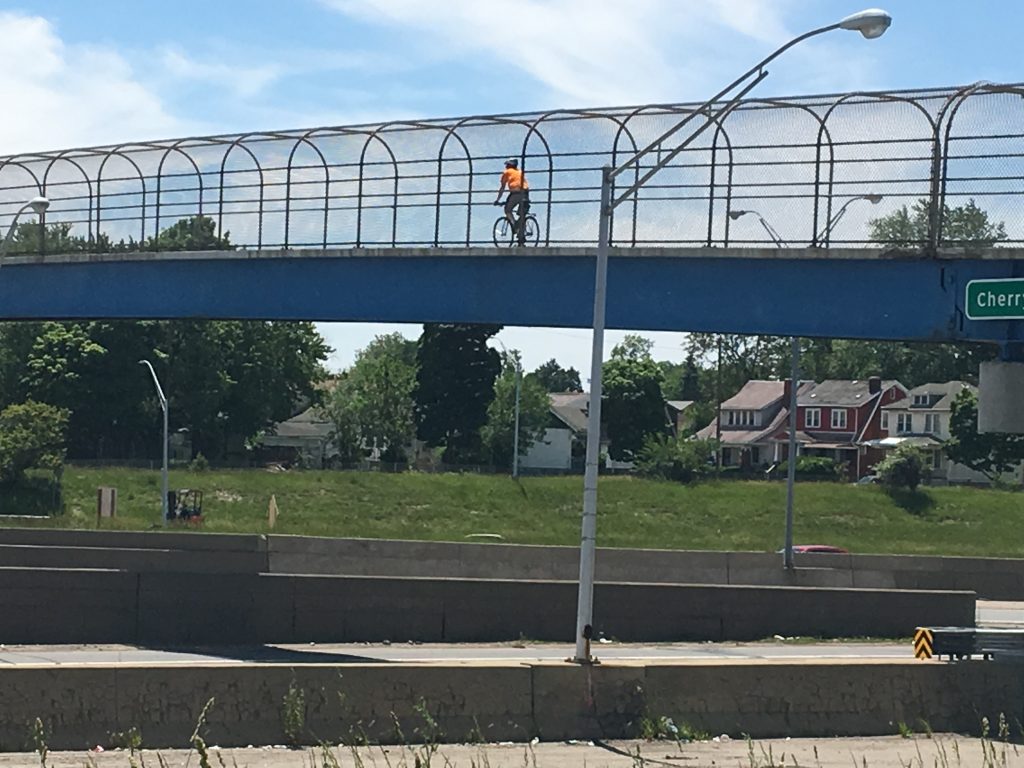
Detroit has some motor-less projects on its agenda including the Inner Circle Greenway, mapped below.
Click on a point on the map to hear about it and follow the link to more information.
To go shopping at Eastern Market, snack at Avalon bakery and get to her Qigong sessions at parks around the city, Emily Rogers is grateful for Detroit’s improving bicycling infrastructure.
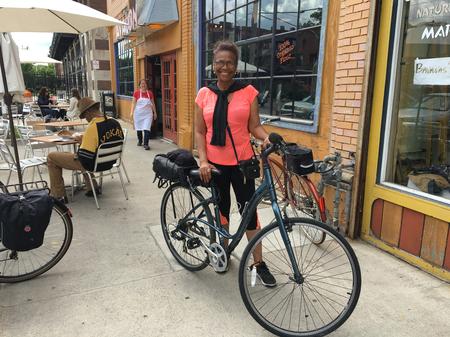
“I like being able to ride freely,” says the 67-year-old retired teacher who lives just outside of downtown. “You can keep your blood circulating, you’re outside, you’re getting a lot of sunshine which energizes you, and it’s just fun. I feel as if I’m a little child when I’m on the bike. I’m usually laughing just going here there and everywhere.”
As Detroit continues to build its infrastructure for non-motorized transportation, specifically bike lanes, more projects every year are moving from the drawing board to the streets.The city has gone from zero bike lanes just a few years ago to 180 miles currently, with another 20 expected to be added this year.
One bigger project in particular, is gaining momentum: The Inner Circle Greenway.

Touted by Mayor Mike Duggan at the recent Mackinac Policy Conference, the roughly 30-mile route would circle through Detroit and Hamtramck and incorporate existing bike lanes in downtown and southwest Detroit as well as greenways. He highlighted the section along McNichols Road. “We’re going to build a greenway through the neighborhood,” Duggan said. “We’re actually going to build a greenway that’s going to look like the Dequindre Cut to connect UD Mercy on the east and Marygrove on the west and that big blue section in the middle is going to be a beautiful park.”
If When further funding is secured, the Inner Circle Greenway also will offer a new off-road pathway along the former Detroit Terminal Railroad route and more on-street bike lanes – possibly protected – to complete the route.
The city has submitted a grant to the U.S. Department of Transportation for further funding to pay for land acquisition — the rail company owns the land, where tracks have already been removed — and construction of the off-road route.
“It will be a whole different about 26 miles of travel and it will connect a whole lot of neighborhoods,” says Mike Darga, senior project engineer with Giffels Webster engineering firm who works on the city’s non-motorized project. “It will give a whole lot of areas where people can connect into that, kind of like the Dequindre Cut. It will be very safe for families and less experienced cyclists.”
Franklin Efford would welcome it. The 56-year-old Detroit man is spending more time on his bike, even shopping recently for a tandem so his partner could join him on rides.
“The main thing is to keep on building on the roads,” says Efford, who lives north of Hamtramck in Detroit. “There’s a lot of roads that are messed up but they’re trying. I can see the improvements. As long as they keep the bike lanes going it will be more safer, and I think everybody (will be) more comfortable at the same time.
To get a street-level view of what’s currently in place for the route and what’s needed to make it a realistic route for commuting and recreational riding, I biked the route with Todd Scott, executive director of the Detroit Greenways Coalition.
We’ve partnered before – in 2014 we rode some 60 miles tracing the route Detroit’s bankruptcy judge took on a bus tour to help him better understand neighborhood conditions related to the city’s historic Chapter 9 case.
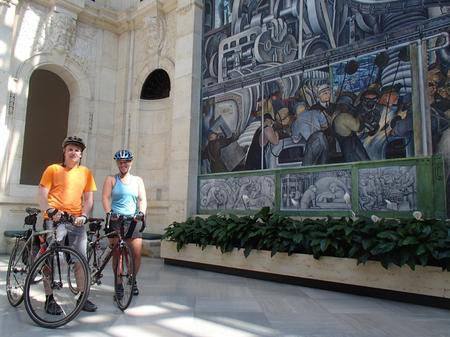
Covering about 30 miles, we traced the route of the Inner Circle Greenway as closely as we could, stopping to talk about what’s there and what could be.
Pedaling the miles and talking with people along the way, we learned more about how bicycling is part of Detroit’s revitalization and involves bigger issues of land-use decisions, urban planning, economic development, creating healthier and sustainable communities and even righting some of the racially motivated wrongs of the past.
Click on our stops on the map above to learn more about the significance of that section.
To let Mayor Mike Duggan know you support the Inner Circle Greenway efforts or to offer suggestions about other bicycling or walking routes, click here.
Here’s what we found on the ride:
The Cut Counts
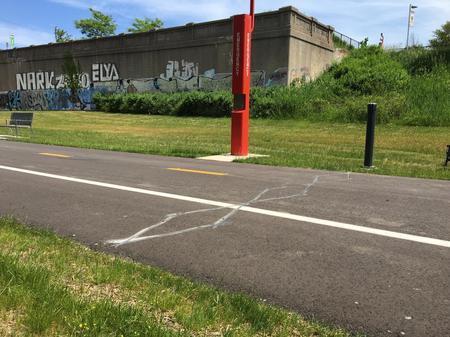
The Dequindre Cut is a below ground nonmotorized pathway built on a former railroad bed. It’s a popular destination for people and canines – there are even organized dog walks that bring dogs and their humans to the route.
So just how many people are walking, biking, skating or otherwise traveling the Dequindre Cut?
A new counter is providing that data. Located just south of the Gratiot overpass, this counter records “warm bodies” and bicycles that pass. Between the beginning of 2016 and Memorial Day, about 51,000 people went by, says Todd Scott, executive director of the Detroit Greenways Coalition. He says that number “astounded” greenway advocates.
The data, he says, is “mind blowing since the trail wasn’t open for most of that period and it was winter. … but it shows that there’s just great demand for it and great use.”
Return to Inner Circle Greenway map
Top of the Cut
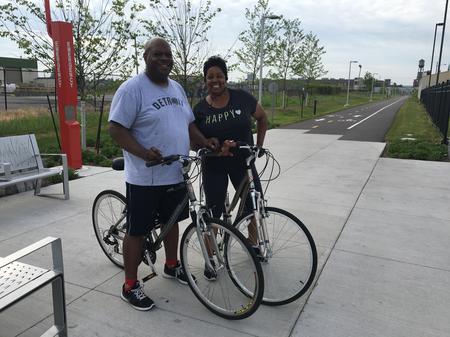
The new-this-year extension to the Dequindre Cut means there is a non-motorized pathway from the riverfront to Mack Avenue. But “this the most pleasant end to the trail,” concedes Todd Scott, executive director of the Detroit Greenways Coalition. The greenway ends at the street, with a new sign and some landscaping, but no well-marked crossing and little parking if you want to start your ride or walk here.
As always, Scott has a vision.
“There’s still a lot more opportunity for us to improve this here so we’re thinking how do we extend the Dequindre Cut further north to connect into the neighborhoods,” he says.
The extension, for the moment, is marked bike lanes heading east on Mack Avenue. Here’s what Scott says about the view to the north from the end of the Cut:
“There’s train tracks. There’s also the possibility of maybe taking away a lane from Dequindre and making it into two-way trail and physically protecting it from the road. We know that Dequindre doesn’t have to be a four-lane road here it could be three. There’s also been problems in the past with people drag racing on this section of Dequindre so if we could maybe solve two problems at once, put a nice trail in, narrow the road a little bit to slow down speeders, we could come up with a win win that would be great.”
But city officials and trail advocates don’t have a long-term, fully established plan beyond the concept of the Inner Circle Greenway.
“That’s why we’re starting to meet now. Right now the solution is bicyclists can go on. We’ve added bike lanes on Mack Avenue riding east one block over to St. Aubin, you go up St. Aubin,” Scott says. “But I know some folks aren’t as comfortable on St. Aubin and the road pavement is not in the best condition so we’re looking at all of the options to see what makes the most sense.”
Return to Inner Circle Greenway map
Street Debris

Glass, gravel and garbage create some of the biggest hazards of riding in Detroit. On St. Aubin Street’s marked bike lanes, we found those items to be an issue on the edge of the pavement, so we rode away from the curb and more into traffic trying to avoid the mess.
“It pushes bikes into the road further where if you have cars coming, it’s not a pleasant experience,” says Todd Scott, executive director of the Detroit Greenways Coalition. “It reflects on the city’s commitment to biking. If this is the treatment cyclists get, it’s not very nice so we need to turn that around and get these swept so they look great and welcoming and get more people to ride in them.”
Along St. Aubin Street north of Mack Avenue, we stopped to kick some debris out of the roadway and notice that as we got further from the downtown portion of the ride, pavement conditions got worse. “We also have some problems with the trees growing into the bike lane,” Scott says. “Sometimes we have vehicles that are parking in the bike lanes. It’s not the ideal situation but it’s an interim solution.”
Return to Inner Circle Greenway map
This Land

A few yards east of St. Aubin Street at Frederick Street, we pause between several large, now-vacant, overgrown lots. It’s the site of John’s Carpet House, a weekly neighborhood blues music happening during the summer. WDET’s Framed By project featured it last year.
We hear birds, see thick clusters of trees and imagine a bike path through here. It’s truly a rural feeling if you don’t look at the industrial lots behind us.“There’s a lot of opportunities with all this green space and all this open space to take the trail off the road and put it through some of this open area. That’s something we can look at,” says Todd Scott, executive director of the Detroit Greenways Coalition. “We really have to come up with a land use plan first. It’s much more than just putting a trail down, but that’s something we look forward to doing in the future.”
Planning for off-road greenways takes more than just deciding some empty space would be good for riding. It takes a longer-range view, Scott says.“First you have to figure out what your land use is going to be,” he says. “Because it’s going to be more than just a trail. Is it going to be low-density residential? Is it going to be agricultural? What is it going to be? Once you figure that out, you can weave the trail through it and make connections.”
Return to Inner Circle Greenway map
Hamtramck Routes
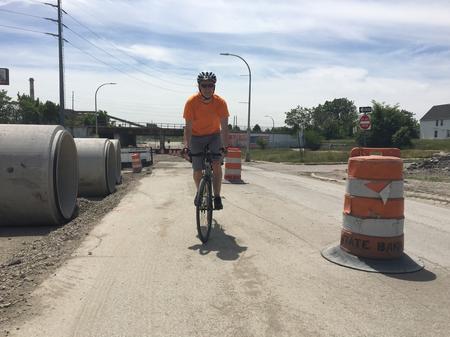
The Inner Circle Greenway route, as presently conceived, travels up Hamtramck’s main street if you’re approaching from downtown Detroit.That’s after you ride north from St. Aubin Street, reach East Grand Boulevard, which becomes Hamtramck Drive and then turn onto Joseph Campau Street.
Todd Scott, executive director of the Detroit Greenways Coalition, says the benefits this could bring to Hamtramck businesses are like those in other commercial districts after streets are made friendlier for pedestrians and riders.“The vision is to make improvements and where we can fit in protected bike lanes, try to help economic development along the road,” he says. “Because national studies show that when you put bike lanes in it actually improves economics for the businesses alongside there. Even though this is Hamtramck and not Detroit, we want to lift all boats. This is just a great opportunity.”
Return to Inner Circle Greenway map
Rails to Trails
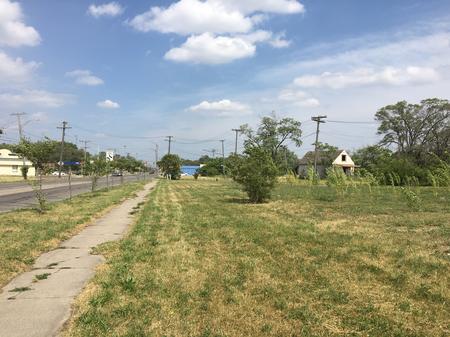
The point where the Inner Circle Greenway’s planned route turns west from Joseph Campau Street onto McNichols Road requires some imagination to see it as a cycling haven.
It’s an industrial section of the city, with many abandoned houses and businesses. The Detroit Terminal Railroad corridor travels through here. The rails are gone, but the bed remains.
Imagine a street-level Dequindre Cut before trees, weeds and debris were removed.
“The thought is that we eventually get this purchased by the city and turned into a rail trail,” says Todd Scott, executive director of the Detroit Greenways Coalition. A grant, submitted by the city to the U.S. Department of Transportation earlier this year, proposes a plan to spend more than $18 million to convert this former train line to a biking and walking route. The city will learn later this year if the funds are awarded. Last year, the feds declined the city’s application.
If awarded, the grant would pay to build out about 5.5 miles of the 8.3 mile former rail line in the city, Scott says, along with other street improvements for cyclists.
“The plans for McNichols between Joseph Campau and Marygrove College are to put in protected bike lanes that will connect a major northern leg of the Inner Circle Greenway,” Scott says. “Once it gets to Livernois, we will also put protected bike lanes on Livernois down to the rail corridor where that will connect between Focus:Hope and southwest Detroit.”
Such a network would do more than just provide a safer place to ride.
“It’s interesting how it connects things all together,” Scott says. “Not just the biking but also the neighborhoods.”
Return to Inner Circle Greenway map
Tandem Dreams
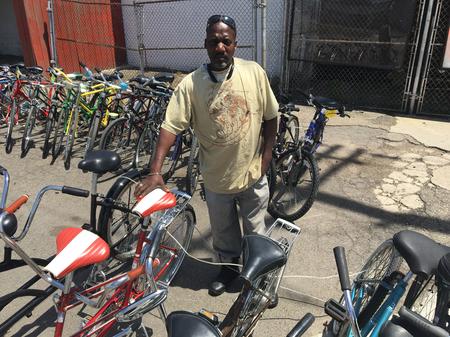
Franklin Efford has his own bicycle.
But with a partner who likes to ride with him, He’s shopping for a tandem.“When one gets tired, they pick up the pace for the other one,” the 56-year-old Detroit man says.
Todd Scott and I met Efford on McNichols Road as we were following the proposed Inner Circle Greenway as closely as we could. Efford says he follows some of the route, riding downtown, on Belle Isle and in many of the city’s different neighborhood. “It seems like there’s a new phase coming on for the last couple years, and every year it seems like it’s getting bigger and bigger,” Efford says. “There’s lots of people getting off into it now.”
He appreciates the recent additions of bike lanes along dozens of miles of Detroit’s streets.“It makes it a little more safer, and the bikers got a little more safeability being in the bike lanes,” Efford says.
Return to Inner Circle Greenway map
Bike Business Booming

A few months ago, the Louis Ace Hardware store at McNichols Road and Oakman Street, started selling bicycles.
“We have cheap ones up to expensive ones, whatever you want to spend. If you want a $35 transportation special, we have those, and then we have really expensive Slow Roller bikes,” says owner Daniel Pugsley.
Residents of the surrounding neighborhood, including a lot of kids, are buying bikes from Pugsley’s store. They’re doing leisurely riding, the Slow Roll and joining the city’s growing number of bike clubs.“There’s new ones popping up all the time. Every third customer we talk to says yeah, they just joined a new bike cub. They’re definitely popping up,” Pugsley says.
Return to Inner Circle Greenway map
Bike Shop
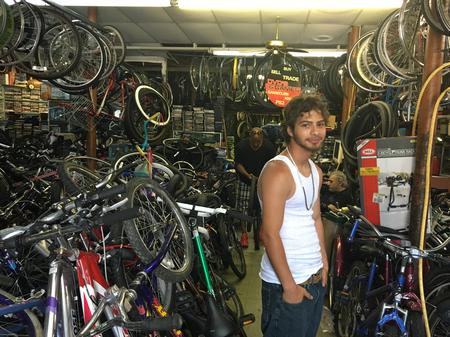
At the Livernois Bike Shop, frames are piled from the front door to the back wall. Kids bikes. Adult-sized bikes. Full frames. Bike parts.
For Majd Maroun, the third generation of the family that owns the store, the business is about more than selling bikes. It’s about the community and what happens when city residents get on bikes and ride.
“We’re all together as one, riding together as one, being together as one. That’s one things for sure. Bicycles actually bringing a lot of people together,” he says.
Return to Inner Circle Greenway map
Popping Up
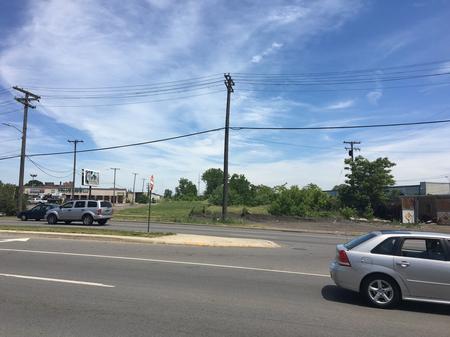
The Inner Circle Greenway plans show a route on Livernois Avenue, a busy thoroughfare that passes by the University of Detroit Mercy.
It’s “very challenging to fit a bike lane in, much less a protected bike lane, given the amount of space,” says Todd Scott, executive director of Detroit Greenways Coalition. A pop-up bike lane shut down cars in April, which Scott says showed that configuration was possible.
“The cars seem to flow equally as well,” he says. Another temporary bike lane is planned for Aug. 6. “The thought is: we can maybe take away one lane of traffic and put in some nice protected bike lanes,” Scott says.
Return to Inner Circle Greenway map
Crossings
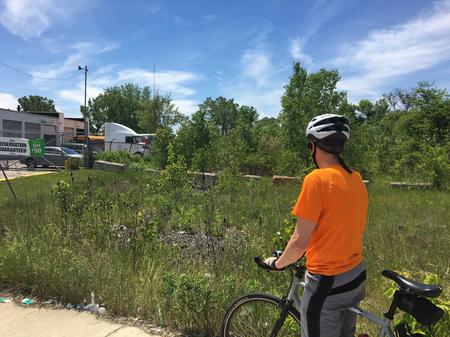
Livernois Avenue passes over the former Detroit Terminal Railroad bed, highlighting one of the issues with building the proposed Inner Circle Greenway: how to route an off-road bicycle and walking path on the former railway when it must cross streets.
Traffic engineers, says Todd Scott, executive director of the Detroit Greenways Coalition, will have their work cut out for them to create routes across the streets that work for drivers, riders and pedestrians.
“This shows one of the big issue that we’re going to have with this trail is how do we make safe crossing of busy roads like Livernois. It’s not like the Dequindre Cut where everything is below grade. We actually have some at-grade road crossings. This one’s probably the busiest, so we’re going to have to spend the most time and effort to make sure it’s the safest,” Scott says.
Return to Inner Circle Greenway map
Building Bridges
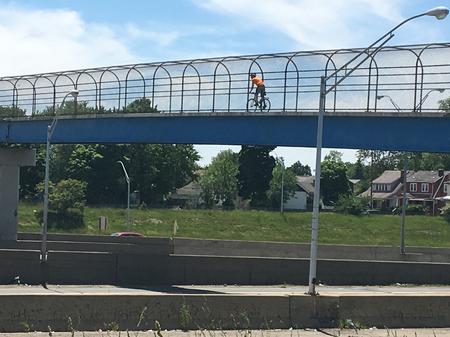
The proposed Inner Circle Greenway route for cyclists and pedestrians includes new bridges over the Jeffries Freeway just south of the existing Cherrylawn Street crossing.
The spans would be for more than bikers and walkers; they’d correct some mistakes made when that interstate was built, says Todd Scott, executive director of the Detroit Greenways Coalition.
The roadway divided a neighborhood when it opened in the 1960s and 1970s.
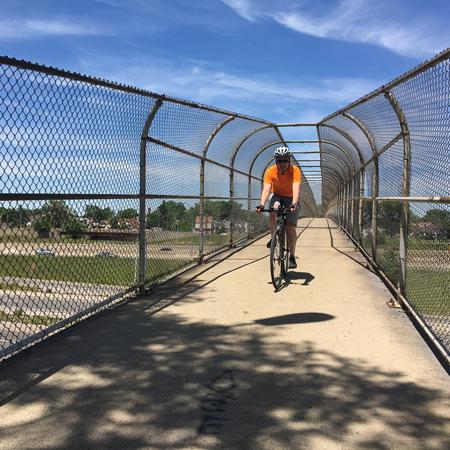
“We’re building connections across the expressway,” Scott says. “We’re reconnecting up some of those communities that we felt were wronged in the past with the way the highways were routed through them and the way they divided them up.”
U.S Transportation Secretary Anthony Foxx earlier this year said highway barriers created during the 20th century were “the result of deliberate decisions to route them through low-
income neighborhoods. Now, decades later, as infrastructure needs replacing or repairing, Foxx says there is an opportunity,” NPR reporter earlier this year. “The values of the 1950s are still embedded in our built environment and the prejudices,” Foxx told NPR. “The notions of who’s in or who’s out are still part of the built environment, and we can do something about it.”
Scott says evidence of that policy are still evident in Detroit.
“Highways in America were built to intentionally go through communities of color or what was called slum areas or substandard areas, and that especially happened in Detroit with the Lodge Expressway and of course I75 and 375,” Scott says. “In fact the Jeffries turns and doesn’t continue north at an angle in order to avoid going through the predominantly white Grandmont Rosedale area in order to protect their property values.”
Return to Inner Circle Greenway map
Community Connections

When the Inner Circle Greenway becomes a reality, it will allow safer travel for cyclists between Detroit and Dearborn. Much of the route follows the Detroit Terminal Railroad route, which is inactive along most of the railway’s bed in the city. But closer to Dearborn at the route’s western edge, the railway is active.
“The rails are still down. The trains are still running on it,” he says Todd Scott, executive director of the Detroit Greenways Coalition.
Planners, according to Scott, haven’t fully settled on how to take the trail of the rail corridor. They could decide to use a bit of Warren Avenue and then head southeast.
Return to Inner Circle Greenway map
Parkland
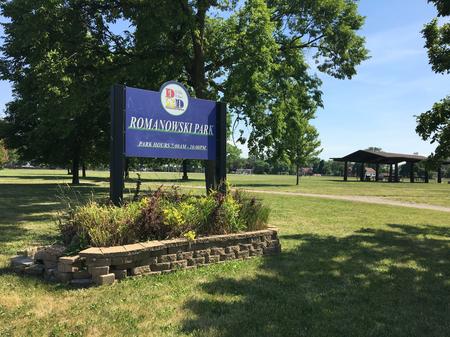
A possible plan would take the Inner Circle Greenway along Lonyo Avenue, which would meet Romanowski Park, a Detroit public space with paved walkways, grass, a shelter and basketball courts. It borders a school in a relatively dense neighborhood.
“We’re thinking maybe we could route the trail along the edge of the park or through the park since it’s a really nice long linear greenspace. Might as well take advantage of it,” Scott says.
Return to Inner Circle Greenway map
Skyline Ride
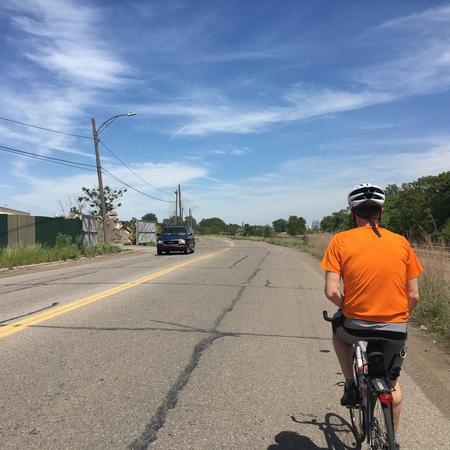
In southwest Detroit, home to Detroit’s first bike lanes, the Inner Circle Greenway route weaves through some of the city’s busiest neighborhoods.
As I rode it with Todd Scott, executive director of the Detroit Greenways Coalition, we encountered students getting out of school, an ice cream truck waiting to make some sales, shoppers heading into the retailers, and other cyclists. Riding this part of the proposed Greenway route presents some of the challenges for planners as they design the route: how to create safer passages for cyclists while intertwining their lanes with businesses, and building collaboration between all of the agencies responsible for Detroit’s streets.
Here’s how Scott describes riding through this section after we came off Lonyo Avenue, went onto John Kronk Street, had a scenic view of the city skyline and then made a turn south onto Central Avenue: “The reason the route does that is because the Detroit International Freight Terminal Project is right there and it’s going to close Lonyo when all the railroad development goes in,” Scott says. “So we went over to Central where MDOT assures us they’re going to improve the road for biking.”
Return to Inner Circle Greenway map
Trails with Rails

When Todd Scott rides the Bagley Street Bridge over the Canadian Pacific rails to Windsor, he sees an off-road route that could take him from the RiverWalk to Mexicantown even if he can’t get down to the grade yet.
What others might see as grassy land along the tracks, Scott, the executive director of the Detroit Greenways Coalition, sees as a potential bike route: off road, paved, marked, connecting existing Detroit greenways to future bike lanes around the city.
“What it would do is you could ride your bike from the RiverWalk all the way to the heart of southwest Detroit on a trail and not have to deal with any cars at all,” Scott says.
What would it take? Cooperation from the Canadian Pacific railroad, which owns the property, for starters.
“Those conversations are ongoing but I think it’s an exciting opportunity,” Scott says. “It would be like a High Line Trail. There would be no road crossings and you could then ride from the Detroit RiverWalk all the way to the heart of southwest Detroit, off road, no cars.”
Return to Inner Circle Greenway map
Routes Around the States

As we ride east from southwest Detroit heading toward downtown, we’re on one road that connects with many routes heading in may directions.
“This trail is actually multiple trails overlaid on top of themselves,” says Todd Scott, executive director of the Detroit Greenways Coalition. “So we have the Inner Circle Greenway. We also have the Underground Railroad Bicycle Route that continues on to Mobile, Alabama. We also have the Iron Belle Trail, which starts at Belle Isle and continues up to Wisconsin. So all three trails are overlaid on top of this route that we’re on today.”
From the Motor City, you can head anywhere on a bicycle.

